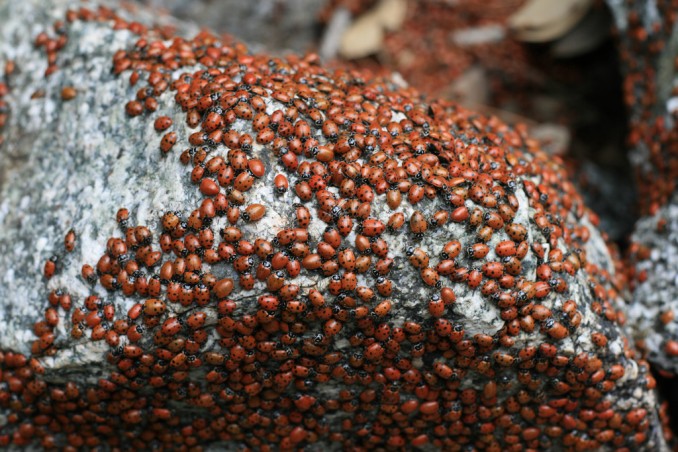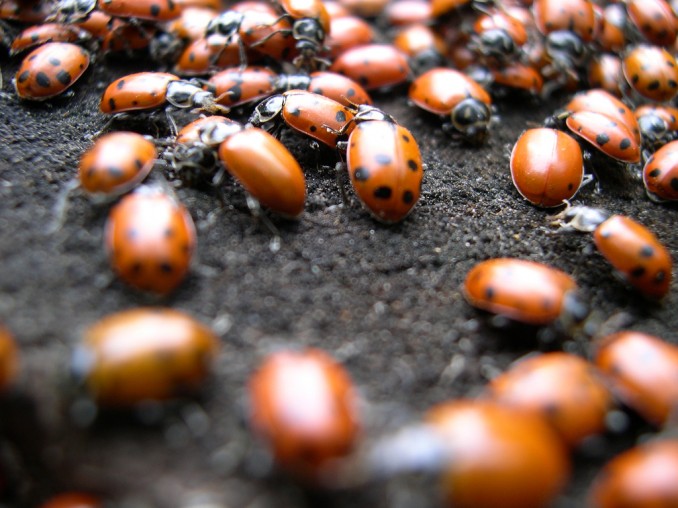
Ladybugs by Jesper Dyhre Nielsen, CC BY-NC-SA 2.0.

Asian lady beetles by Randy McEoin, CC BY 2.0
Not sure if that is a ladybug or an Asian lady beetle that you are seeing? Because the two species are so closely related, the question can be difficult to answer unless you know what what to look for. Let’s explore the similarities and differences between these cousins.
Physical appearance
The quickest way differentiate them is by their color. Most everyone knows what a ladybug looks like; its back is usually bright red colored and interspersed with black spots. Asian lady beetles, in contrast, are commonly orange or yellow with black spots, and sometimes they are black with red spots.
Both beetles are roughly the same size, with the Asian lady being just a little bit bigger, so size is not the best way to differentiate the two.
Behavior
There are a few important behavioral differences between the two that help to distinguish them. These characteristics are obviously not as identifiable at a quick glance like their color is, however.
First, the Asian lady beetle tends to swarm whereas the ladybug does not. Asian beetles will congregate on flat surfaces, especially those exposed to direct sunlight, in order to heat up their bodies. If you see a group of beetles in close proximity they are probably Asian ladies. Windowpanes and the sides of building structures are favored hangout places for Asian beetles.
Secondly, Asian beetles are more likely to infest homes and buildings. If a crack in a wall or door frame is large enough, it can provide an easy entrance point for these insects, so be sure to caulk any cracks in the structure of your home.
Thirdly, Asian lady beetles overwinter, or hibernate through the winter, whereas ladybugs do not. It is because of this that Asian beetles are more of an infestation problem. They look for sheltered areas such as homes and garages where they can safely spend the winter.

Asian Lady by Eric Heupel, CC BY-NC 2.0
Another difference between the two beetles is that Asian ladies give off a very unpleasant smell when they are stepped on or squashed. They also release yellow slime from their exoskeleton which can cause lasting stains. Also, Asian lady beetles bite people more often. Ladybugs do not release this foul-smelling liquid, nor are they as prone to biting.
So, be more careful when you encounter Asian lady beetles. Never mash them, step on them, or swat them away with your hand unless for some reason you want to be doused with the pungent smell of rotting foliage and marked with a yellow stain.
Origins
There are over 40 different species of ladybug which are native to North America. They are much more common than Asian lady beetles in the United States.
As the name suggests, the Asian beetles originated in the far east and were brought to the United States early last century. They are very useful as a means of aphid control, and that is the original reason why they were brought here.
It took decades for Asian beetles to gain a foothold on this continent, at first being restricted to southern cities such as New Orleans. Now however, they can be found pretty much coast-to-coast.
Habitat
The beetles share similar habitat preferences. They love forests and grasslands. Both prefer warm to hot temperatures, and humidity.
Conclusion
So, it seems the ladybugs could be considered the cute and adorable ones, while the Asian ladies are there more aggressive and cantankerous cousins. Definitely be more wary when handling Asian ladies. The ladybugs a more docile and generally cause less of a headache for humans.

ladybugs by flash gordon md, CC BY-NC 2.0

Leave a Comment